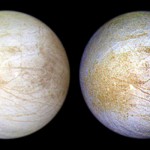Another try at improving my planetary technique. A bit better, notably because the raw material was shot from the summit where the seeing is much better. it was not a great night for Mauna Kea, but it was much better than Waikoloa…

When you want to see the stars, find someplace dark
W. M. Keck Observatory press release…
Observations of Europa from the W. M. Keck Observatory help NASA and California Institute of Technology (Caltech) astronomers go one step further in demonstrating life may be possible in the ocean of one of Jupiter’s moons. In addition to the known existence of water, a paper published today shows hydrogen peroxide is abundant across much of the surface of the smallest of the Galilean Moons. The paper argues that if the peroxide on the surface of Europa mixes into the ocean below, it could be an important energy supply for simple forms of life. The paper was published online in the Astrophysical Journal Letters.
(On March 14, a separate paper was published by the same team in Astronomical Journal, demonstrating the salty ocean of Europa makes its way through the frozen surface, introducing the possibility the ocean is habitable. Click here for that news release.)
“Life as we know it needs liquid water, elements like carbon, nitrogen, phosphorus and sulfur, and it needs some form of chemical or light energy to get the business of life done,” said Kevin Hand, the paper’s lead author, based at NASA’s Jet Propulsion Laboratory, Pasadena, Calif. “Europa has the liquid water and elements, and we think that compounds like peroxide might be an important part of the energy requirement. The availability of oxidants like peroxide on Earth was a critical part of the rise of complex, multicellular life.”

The scientists think hydrogen peroxide is an important factor for the habitability of the global liquid water ocean under Europa’s icy crust because hydrogen peroxide decays to oxygen when mixed into liquid water. “At Europa, abundant compounds like peroxide could help to satisfy the chemical energy requirement needed for life within the ocean, if the peroxide is mixed into the ocean,” said Hand.
Co-author Mike Brown of Caltech in Pasadena, analyzed data collected from the Near-Infrared Echelle Spectrograph (NIRSPEC) and OH Suppressing Infra-Red Imaging Spectrograph (OSIRIS) instruments on the mighty Keck II telescope on Mauna Kea, Hawaii, over four nights in September 2011. The highest concentration of peroxide found was on the side of Europa that always leads in its orbit around Jupiter, with a peroxide abundance of 0.12 percent relative to water. (This is roughly 20 times more diluted than the hydrogen peroxide mixture available at drug stores.) The concentration of peroxide in Europa’s ice then drops off to nearly zero on the hemisphere of Europa that faces backward in its orbit.
Hydrogen peroxide was first detected on Europa by NASA’s Galileo mission, which explored the Jupiter system from 1995 to 2003, but Galileo observations were of a limited region. The data from Keck Observatory shows that peroxide is widespread across much of the surface of Europa, and the highest concentrations are reached in regions where Europa’s ice is nearly pure water with very little sulfur contamination. The peroxide is created by the intense radiation processing of Europa’s surface ice that comes from the moon’s location within Jupiter’s strong magnetic field.
“The Galileo measurements gave us tantalizing hints of what might be happening all over the surface of Europa, and we’ve now been able to quantify that with our Keck telescope observations,” Brown said. “What we still don’t know is how the surface and the ocean mix, which would provide a mechanism for any life to use the peroxide.”
W. M. Keck Observatory press release…
With data collected from the W. M. Keck Observatory, California Institute of Technology (Caltech) astronomer Mike Brown — known as the Pluto killer for discovering a Kuiper-belt object that led to the demotion of Pluto from planetary status — and Kevin Hand from the Jet Propulsion Laboratory (JPL) have found the strongest evidence yet that salty water from the vast liquid ocean beneath Europa’s frozen exterior actually makes its way to the surface.
The data suggests there is a chemical exchange between the ocean and surface, making the ocean a richer chemical environment, and implies that learning more about the ocean could be as simple as analyzing the moon’s surface. The work is described in a paper that has been accepted for publication in the Astronomical Journal.
The findings were derived from spectroscopy delivered from the Keck Observatory, which operates the largest and most scientifically productive telescopes on Earth.
“We now have the best spectrum of this thing in the world,” Brown says. “Nobody knew there was this little dip in the spectrum because no one had the resolution to zoom in on it before.”
Continue reading “Astronomers Open Window Into Europa’s Ocean”